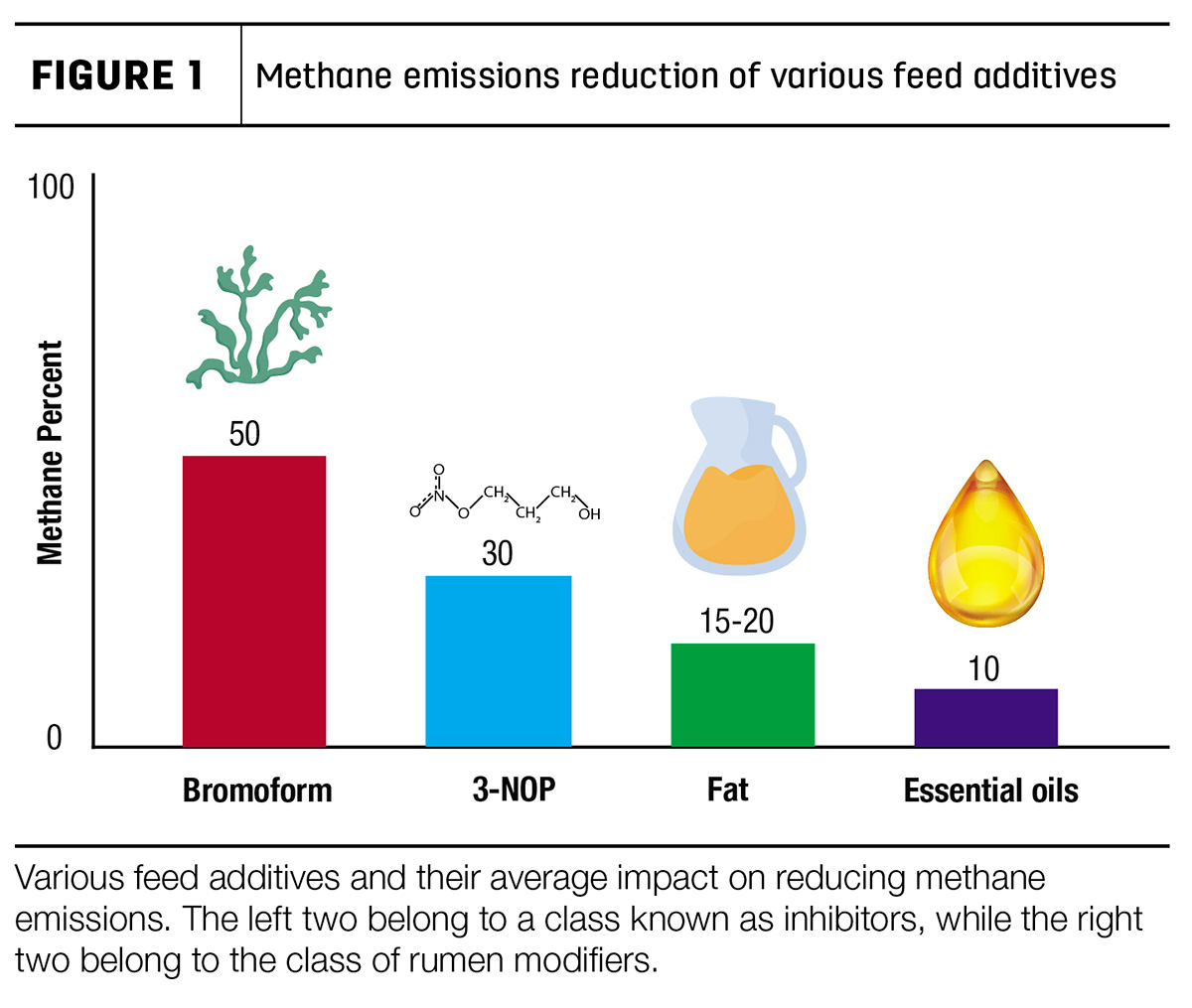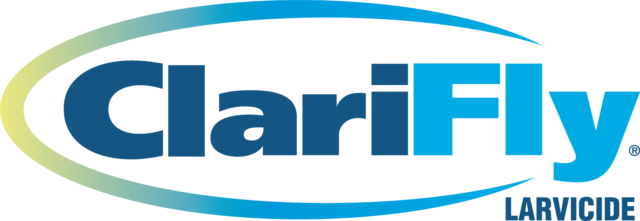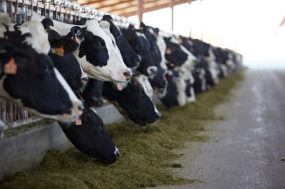Dairy cattle have the power to turn grasses and forages into milk and meat. Their unique digestive system allows them to break down this fiber and turn it into human-consumable food. In the process, a handful of microbes – less than 1% – produce methane, which is eventually burped out by the cows. Despite their small numbers, these methane producers receive big attention from consumers.
It’s not altogether unfair. Methane is a potent greenhouse gas (GHG) that warms at a greater rate than carbon dioxide in the short term. Plus, as the planet gets ever hotter, all sectors – dairy among them – need to pitch in and reduce their own emission footprint.
Assuming we don’t want to cut back on our production of meat and dairy (there are compelling arguments that make the case for why we shouldn’t), there is ongoing research from vaccines to genetics to feed additives to reduce methane emissions in cows.
Additives have been highlighted as the best way to reduce enteric methane emissions in the short term due to their ease of applicability in a dairy farm. Typically, additives account for less than 1% of a dairy cow’s diet, but they have a drastic impact on enteric methane – up to 30% on commercial farms. Put another way, a feed additive is roughly equivalent to the spices in a meal. Just as these seasonings make a difference in the taste and texture of your food, additives can have a major impact on methane emissions. However, they only work if cows eat them daily. It’s not easy to incorporate additives to ensure consistent methane reductions while maintaining cow health and milk production, but it's worth the effort.
Feed additives aren’t equal in how they reduce methane emissions. The two main classes of additives are methane inhibitors and rumen modifiers. The former acts directly on the enzymes that produce methane in cows’ guts. The latter alters the rumen environment, making it less favorable for methane emissions to form in the first place. Inhibitors can achieve greater methane reductions; they’re akin to cutting the head off the proverbial snake by targeting the process that results in methane formation instead of reducing the probability that methane emissions will form. There are opportunities for both on farms, depending on management goals, the feeding system and pricing. The aim is to find the right combination of additives for an operation, given various incentives, impact on animal performance and availability.
Inhibitors stop methane in its tracks
Methane is the result of a precise recipe that requires hydrogen and carbon dioxide. Methane can’t be formed – and emissions can’t take place – if any of the recipe’s steps is circumvented. Inhibitors do that; they disrupt a recipe step so methane can’t be formed.
There are two main groupings of inhibitors that are effective in reducing methane today: 3-nitrooxypropanol (3-NOP) and bromoform (Figure 1). 3-NOP is a synthetic molecule set to be available to U.S. farmers by the middle of this year. This additive reduces methane by 20% to 30% on farms and has set itself apart as the additive that could most readily reduce dairy enteric methane emissions in the next few years.

The other main inhibitor is bromoform, found naturally in red seaweed varieties. Bromoform works similarly to 3-NOP by eliminating a step of the methane-formation recipe and has achieved up to 50% methane emission reductions in short-term research settings. However, long-term studies are not realizing the same massive reductions in methane emissions. Additionally, concerns remain about the additive’s impact on animal health and palatability and ensuring that it does not impact milk and meat. At this point, no farms are using these methane inhibitors, but rumen modifiers have made their presence felt on hundreds of farms.
Altering the rumen environment for methane mitigation
Rumen modifiers also curb methane production. These additives cut methane at a lower rate than inhibitors through reducing the compounds – that is, hydrogen or carbon dioxide – that methane formation requires, attacking the methane-producing microbes or by making the rumen environment less favorable for methane formation.
The broad classes of rumen modifiers include essential oils, ionophores, nitrates, tannins and fat supplementations (Figure 1). Currently, farmers are feeding some of these additives to their cows because of the positive impact they can have on milk production. The net reduction of 2% to 15% in methane emissions is just icing on the cake.
The remaining unknowns of methane-reducing feed additives
While we have made significant progress from where we were just a decade ago, there are still countless unknowns remaining. The areas with open opportunity for methane reduction utilizing feed additives include (Figure 2):
- Grazing animals
- Long-term implications
- Calf and youngstock interventions
- Multiple feed additives at once

Grazing dairies are located across the country, from the rolling hills of New York to the coastal plains of Oregon. In a conventional dairy, everything the cow eats is placed in front of them and nutritionists can formulate the diet down to the specific bite. However, when cows are raised on pasture, it is a little more challenging to deliver the feed additive to the cow. Novel methodologies such as bolus treatments, water-based solutions and trace mineral mixes may be needed. Much of our progress in this area will be thanks to research from the beef cattle sector as they seek to reduce methane from tens of millions of cows that graze rangelands across the U.S.
Research is expensive, challenging and takes significant time and resources. Almost all research on these methane-reducing feed additives has taken place in a four-month-or-less time frame. However, these additives won’t be included in rations for a week or a month but for multiple years and lactations. We remain cautiously optimistic about certain additives and wonder if they will lose their potency or methane-reducing ability once they’ve been fed for multiple years. With promising candidates, a handful of investigations are being made around the world to target this very question.
Also, we can influence the amount of milk a cow will produce in her lifetime by investing in their nutrition and health through early life programming in their first few months of life. This begs the question: If we feed our calves an additive early on in life, will that impact lifetime methane production? What if it was as easy as changing our calf-feeding protocols to reduce the carbon footprint of a dairy farm? While this may seem like a bold idea, it would be irresponsible to not go after it.
Lastly, if one feed additive works well, does that mean two together are even better? Different classes of feed additives reduce methane in different ways depending on if they are an inhibitor or a modifier. This strategy could potentially have a double-whammy impact by altering the playing field against the methane-producing microbes. In the limited number of investigations, this strategy hasn’t panned out just yet. While we’re just starting out, we will likely need a combination of additives and other factors such as genetics and management that will play the greatest role in reducing methane on dairy farms.
Making green while going green with carbon credits
There’s no such thing as a free lunch, and that applies to feed additives. We must make it feasible for farmers – who often work with impossibly tight budgets – to adopt new technology. One way is to compensate them with carbon credits. These credits are tradeable tokens that represent the reduction of 1 ton of carbon dioxide equivalent. To put that in perspective, this is equivalent to the amount of methane burped by 100 lactating cows a day.
Like an admission ticket, a carbon credit can only be sold once, and there are several customers both in and out of the dairy supply chain hungry to buy these credits. Researchers at Colorado State and Ohio State universities are doing cost analyses to determine the break-even point for a farmer looking to fund feed additives through the sale of carbon credits. As we work to find solutions to reduce methane emissions, economic sustainability will be key to help producers afford the long-term adoption of these feed additives.
Scratching the surface of methane reduction
Few methane-reducing feed additives are being used on U.S. farms, but momentum is building. Making these products available and incentivizing farmers to use them will allow us to achieve the vast methane reductions we need. Answers on who will foot the bill for these additives are needed, as farmers are concerned about the financial costs if utilizing these additives results in no benefits for animal health or milk production. Universities, such as the University of California – Davis and others around the world are working daily on more and better methane-reducing candidates for dairy farms. With enough time and research, there could be technologies that offer the best of both worlds: drastically reducing methane emissions and improving milk production and animal health.
At the end of the day, these feed additives are likely to make an impact in the carbon footprint for dairies of all sizes. The opportunity is ripe for the taking, and dairy farmers need to be empowered to add a dash of an additive to make a huge impact for cows and climate.









